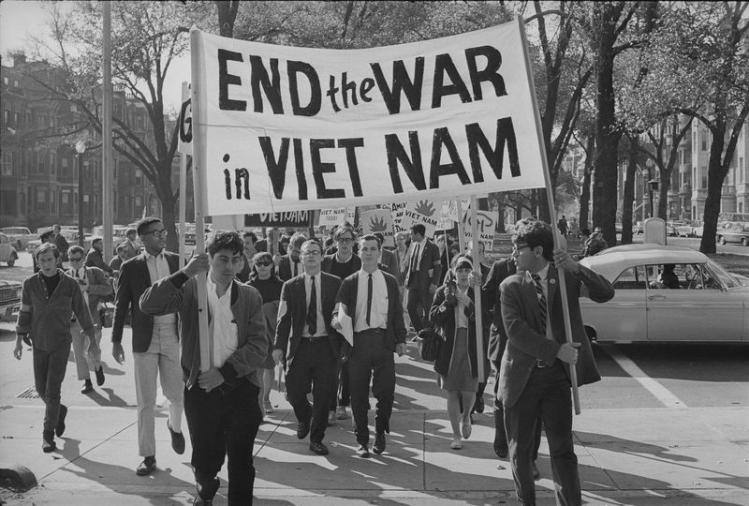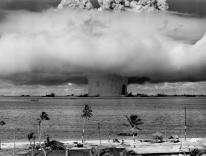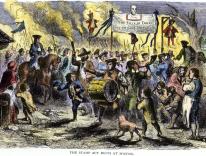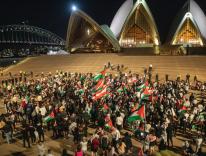
Ken Burns and Lynn Novick’s 2017 documentary The Vietnam War is a brilliant antiwar film that humanizes the enemy and laments the brutal slaughter of roughly three million soldiers and civilians for absolutely nothing. It is also a ringing indictment of those American presidents who waged the war, consistently lied to the American public about how they were waging it, and sent tens of thousands of young American soldiers to fight knowing it could not be won. As such, it also offers an urgent warning about the nature of the wars we continue to wage.
Yet The Vietnam War has some blind spots. Although the antiwar movement is featured prominently, Burns and Novick do not do justice to its massive public support and substantial role in bringing the war to a swifter end. At the root of this omission is the fact that the film never mentions the interfaith antiwar movement. Burns and Novick feature Martin Luther King Jr.’s courageous speech against the war at Riverside Chapel in Harlem, but it is never connected to the larger interreligious peace movement that had gotten underway several years earlier. In fact, Christian, Jewish, and Buddhist activists were at the forefront of the movement, and their leadership constituted the greatest example of interfaith peace activism in our nation’s history.
In the summer of 1963, almost two years before the United States officially had ground troops in Vietnam and at least a year before there was any recognizable peace movement, Catholic Worker co-founder and peace activist Dorothy Day led the first Vietnam War protests. In 1964, Daniel and Philip Berrigan, Tom Cornell, Martin Corbin, and Jim Forest co-founded the Catholic Peace Fellowship. That November, Trappist monk Thomas Merton, dubbed “the pastor of the peace movement” by Catholic pacifist John Dear, hosted a three-day retreat at his monastery in Kentucky on the spiritual roots of protest. The retreat was attended by people of all faiths and helped in spreading the movement of nonviolent resistance.
In 1965, interfaith peace activist Rabbi Abraham Joshua Heschel formed the Clergy and Laity Concerned about the War in Vietnam (CALCAV) with Daniel Berrigan and then-Lutheran theologian Richard Neuhaus. They were soon joined by King, Harvey Cox, William Sloane Coffin, and Reinhold Niebuhr, making CALCAV the largest religious peace group in the country.
Heschel, who claimed to have been jolted out of his academic study by injustice and warfare, was the most powerful and influential Jewish voice in the movement (“To speak about God and remain silent on Vietnam is blasphemous.”). As early as July 1964, he had traveled to Kentucky to discuss theology and peace strategies with Merton. Vietnamese Buddhist monk Thich Nhat Hanh claimed that he too was unable to remain in the meditation halls while villages were being bombed around him. Proclaiming, “If it isn’t engaged Buddhism, it isn’t Buddhism,” Nhat Hanh came to the United States to “teach peace.” He worked closely with Merton and Daniel Berrigan, and, in May 1966, he addressed the monks in Merton’s monastery.
Burns and Novick dutifully include infamous footage of the 1963 self-immolation of a Buddhist monk protesting the Diem regime. They might well have also shown the self-immolation of Roger Laporte, a Catholic Worker, in front of the United Nations Building in November 1965, just eight months after the U.S. officially put ground troops in Vietnam. Whereas there is a tradition of self-immolation as an extreme form of protest in Buddhism, nothing similar existed in Catholicism. As this was suicide, Laporte could not be buried in sacred ground.
Daniel Berrigan, a Jesuit priest, was strictly forbidden to speak about Laporte’s death publicly. But at a memorial service at the Catholic Worker house, he spoke both publicly and positively about Laporte. It was one of his finest hours: He argued that, whereas suicide proceeds from despair and loss of hope, Laporte had died in another spirit, where death is conceived of as a gift of life. However misguided the act, Berrigan saw it as an offering of self so that others might live. This thinly veiled reference to Christ’s death infuriated his superiors. Berrigan was ostracized and quickly shipped out to Latin America by the Jesuit order.
Daniel’s friends reacted. There were demonstrations at Catholic universities and in front of the office of the Archbishop of New York, Cardinal Francis Joseph Spellman. On December 12, 1965, they took out a full-page ad in the New York Times protesting Berrigan’s “exile” and the violation of his right to “freedom of conscience.” After four months in Latin America, Daniel returned to New York. In 1967, he and his brother Philip became the first Catholic priests to be arrested for opposing the war. In January 1968, he and activist Howard Zinn, on an invitation from the North Vietnamese government, flew to Hanoi to bring home three captive American airmen.
When Daniel Berrigan returned from North Vietnam, he fully understood the limitations of his earlier protests (vigils, petitions, even draft-card burnings) and was ready to risk more serious consequences to engage in radical resistance. On May 17, 1968, he and eight others entered Local Draft Board No. 33 in Catonsville, Maryland. They seized Selective Service records (378 individual 1-A classification folders) and burned them outside the building with homemade napalm. Berrigan explained that this action was intended to show that “killing was repugnant to the letter and spirit of the Sermon on the Mount.” The October trial of those who came to be known as “the Catonsville Nine” was a cause célèbre; hundreds of people gathered at the courthouse every day.
Although members of the interfaith antiwar movement worked together for a common goal, some disagreed with the Berrigans’ methods. Heschel did not practice civil disobedience and thought that going to jail was a waste of time. Dorothy Day was a purely nonviolent protester who did not approve of the destruction of property. Although she acknowledged the disproportion between burning paper and burning children with napalm, she nonetheless maintained that “these actions are not ours.” Like Day, Merton espoused complete nonviolence. Merton’s fear was that violence toward property might easily escalate to violence against people and that, in the long run, such actions might prove counterproductive.
Yet even as the Berrigans stood their ground on the issue of violence toward “idolatrous things,” maintaining that “some property has no right to exist,” their fellow activists nevertheless expressed their solidarity. Day attended every day of the trial of the Catonsville Nine. Heschel drove with Daniel Berrigan and artist Tom Lewis to the Danbury Correctional Institute in Connecticut to meet Philip Berrigan when he was released from prison. In the spring of 2010, the last time I visited Daniel Berrigan, he made a point of showing me the blown-up, framed photograph of him and Heschel as they set out that morning for Danbury. In his autobiography, Daniel referred to Heschel as a “saint, before the judgment” and “a father to me, in more senses than one.”
We are indebted to Burns and Novick for the intimate portraits they present to us of the heavy burdens that so many soldiers bore. The film reminds us how urgent it is to reach out with great compassion to our returning veterans. But if Burns and Novick had shown us the story of these interfaith peace workers, they could have also stressed the wisdom of finding nonviolent solutions to international conflicts.
Please email comments to [email protected] and join the conversation on our Facebook page.
Previous Story
Time to Take Responsibility
Next Story
Poetry: Eight Distillations


